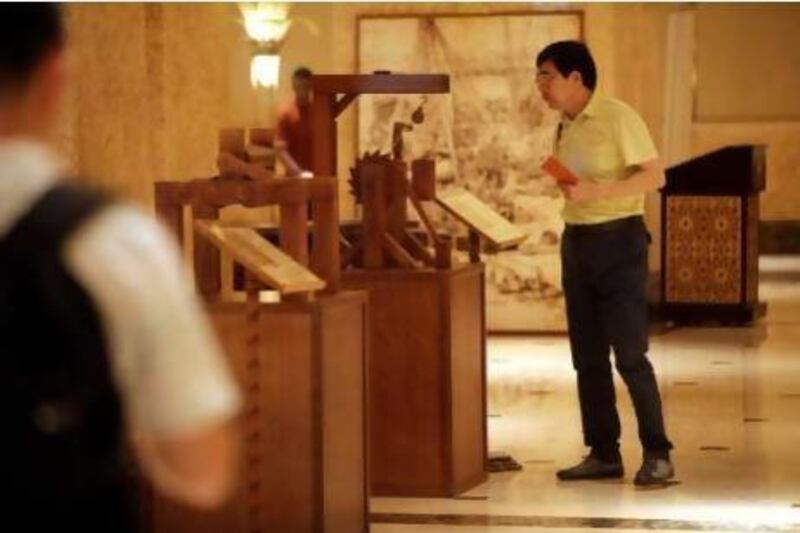ABU DHABI // Walking on water, flying through the air and lifting heavy objects as if they weighed nothing at all were just a few of the dreams of Leonardo da Vinci, one of the grand masters of the Italian Renaissance.
His genius in painting, sculpting and invention have now come to life at the Emirates Palace hotel.
The exhibition, Leonardo da Vinci - The Genius and his Inventions, opened to the public yesterday and showcases Leonardo and his creative legacy.
Built from dark, smooth wood and white ropes, the more than 40 machines on display are technologically simple by today's standards, although they come from a mind of great complexity. Pulleys, gears and levers work together in innovative ways to make use of natural forces such as momentum, gravity and air currents.
According to Augusto Biagi, the exhibition's benefactor, a team of engineers and carpenters used Leonardo's original designs, found in his manuscripts and notebooks, to build the machines. The pieces at Emirates Palace were produced in about a year and a half, and descriptive panels with reproductions of Leonardo's original drawings accompany each model.
Dr Kamiel Gabriel, assistant provost at Zayed University and the author of a forthcoming book entitled The Anatomy of Innovation, has studied Leonardo's work intensively and was excited to tour the exhibits.
"You can read about these designs," Dr Gabriel said, "but to see the real thing is fantastic. Leonardo had a sheer love for curiosity, but he was an inventor, not an entrepreneur. Most of his creations didn't make it to the marketplace."
A tourist from Auckland, New Zealand, was drawn to the exhibition while wandering through the hotel. Having read a book about Leonardo, she said, the machines intrigued her.
"It's so nice to have his drawings right beside the machines, so you can see how he wanted them to work. The illustrations give you more of an idea of his thought processes," she said.
An interactive virtual experience of the exhibition allows visitors to explore the life and works of the artist, animating the machines shown in the exhibition itself. Seeing the designs in motion helps visitors to understand their practical purpose. One, for example, is an odometer that turns as a wheel is rolled, dropping pebbles into a cup after a series of rotations.
Some machines come to life simply because their movements are so easily visualised, while others seem to move by themselves, as if by magic.
A young boy stood transfixed by one contraption, a clock mechanism that ran using momentum: a small metal chain spun around one wooden rod, then swung across to wrap around an identical rod on the other side of the clock's face, turning gears in the process that moved the hands of the clock. It was mesmerising, and incredible that something designed in the 16th century could remain so technologically captivating today.
Many of the mechanisms designed and principles of physics discovered by Leonardo are in use today.
"See this gear system?" asked Dr Gabriel, who trained as an engineer, pointing to an apparatus called the worm screw. He explained the mechanics of the device and then laughed. "You can find this in your car engine."
The exhibition runs until July 5.






